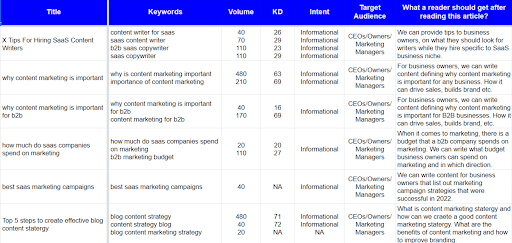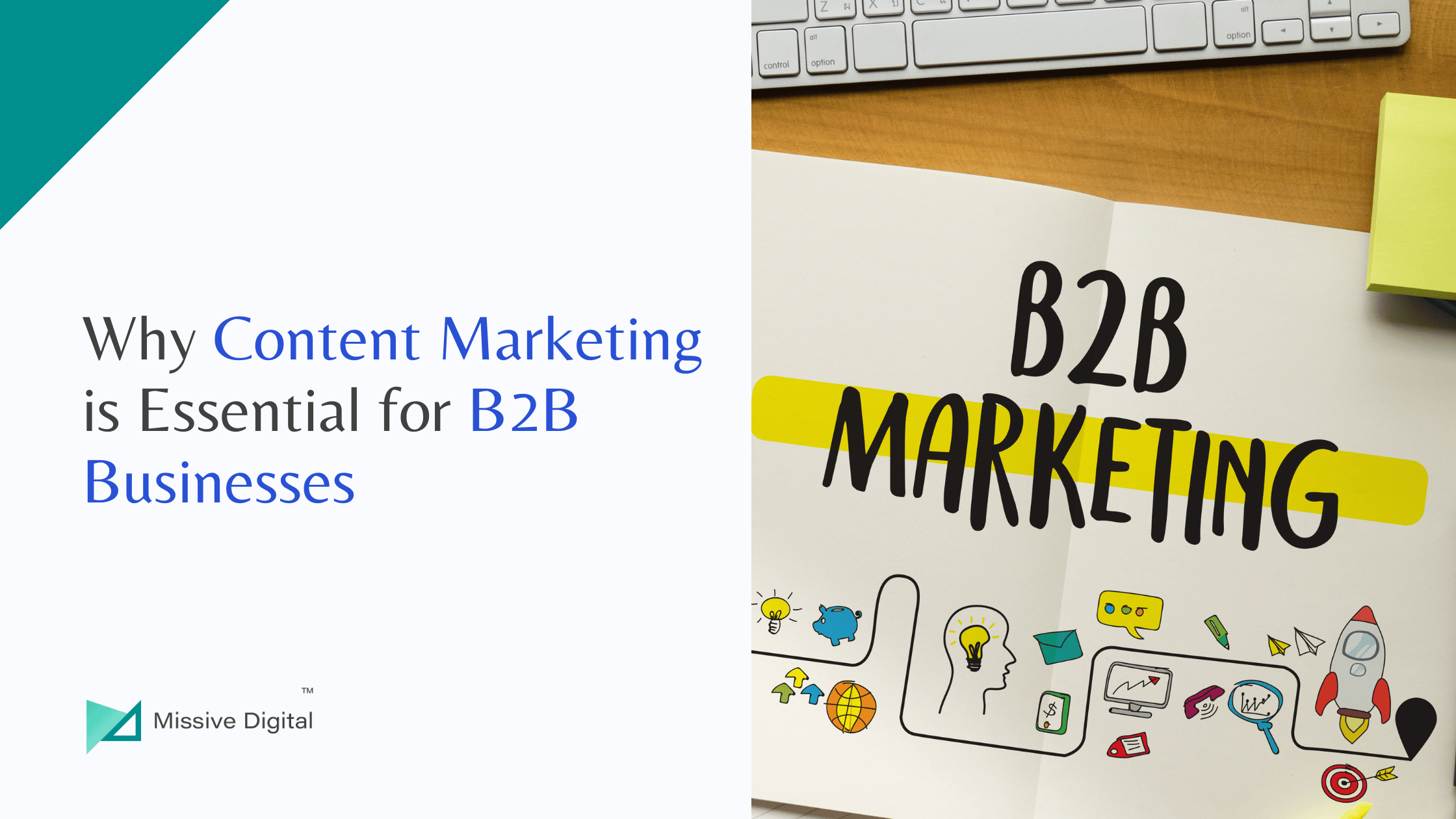Content marketing is a powerful strategy for B2B businesses to create relationships with potential buyers and drive long-term sales. The benefits of content marketing are significant for B2B companies because such businesses typically have longer sales cycles and require more education to convert leads into paying customers.
Content marketing is a cost-effective way for B2B companies to reach their target audience, build trust, and differentiate themselves from the competition. By creating helpful and relevant content, businesses can position themselves as thought leaders, build relationships with customers, and generate leads that can be converted into revenue.
Content marketing also helps B2B companies stay top-of-mind with their target audience and build credibility. In short, content marketing is an integral part of any B2B company’s marketing strategy and is key to generating leads, building trust, and driving long-term sales.
I’ve covered the importance of content marketing for general business purposes in a blog I’ve recently published.
This blog post will solely focus on what exclusive content marketing brings for B2B businesses. So without further ado, let’s dive in.
Types of content reviewed during the B2B buyer journey:
- Blog (71%)
- Case studies (79%)
- Webinars (66%)
- Video (49%)
- Interactive content (36%)
Source: DemandGen Report
4 Benefits of Content Marketing for B2B Businesses
The following are the reasons why B2B brands find content marketing to be a value-driven approach:
1. Content Marketing Compliments B2B Sales Pipeline
Content marketing can complement each B2B sales pipeline stage by providing valuable information and resources to help progress leads toward a sale.
Let’s articulate this argument.
- Awareness: At the top of the sales pipeline, content marketing can help to increase brand awareness and attract potential customers through channels such as social media, search engines, and industry events. For example, a B2B software company could create an engaging video series showcasing its products’ benefits and how they solve common business challenges.
- Interest: Once a lead is aware of the company and its offerings, content marketing can be used to gain their interest and educate them further. For example, a B2B software company could create an eBook or whitepaper that provides in-depth information on a specific topic related to its product.
- Consideration: At this stage, content marketing can build trust and establish the company as a thought leader in the industry. For example, a B2B software company could create a webinar or live demo that showcases the features and benefits of their products.
- Intent: Content marketing can be used to help leads express their intent to purchase by providing them with resources that demonstrate the ROI of the product. For example, a B2B SaaS company could create a cost-benefit analysis tool or ROI calculator to help prospects understand the value of their product.
- Evaluation: At the bottom of the sales pipeline, content marketing can help to provide additional information and resources that support the lead’s evaluation of the product and move them closer to a sale. For example, a B2B software company could create case studies or customer testimonial videos that demonstrate the success of its product.
In this way, content marketing can play a critical role in each stage of the B2B sales pipeline, helping to attract, educate, build trust, and ultimately convert leads into customers.
2. Helps Beat the Competition by Dominating SERP
Content marketing is essential for B2B companies looking to stay ahead of the competition. One way to do this is by dominating the search engine results page (SERP) and taking the top spots for the most competitive keywords in their industry.
By creating helpful, relevant, and engaging content that attracts visitors and provides valuable information, B2B businesses improve their SEO, helping them gain more visibility on search engines.
This increased visibility means that more potential customers will see the company’s content first – rather than their competitors – when they are searching for information relating to a product or service.
Let’s take an example from the B2B software industry to articulate this argument. Companies in this industry want to rank highly for keywords like “bookkeeping services” or “outsourcing bookkeeping services.” To do this, these companies must create helpful content related to these topics that outrank their competition on SERPs. This could include blog posts, white papers, case studies, webinars, eBooks, and other types of content relevant to users looking for solutions in enterprise ERP software or budgeting software.
By consistently producing high-quality content that ranks highly on SERPs and provides valuable information to potential customers looking for enterprise solutions, B2B companies can stand out from competitors as thought leaders in the industry and position themselves as go-to experts when it comes time to make decisions about budgeting or ERP solutions for their businesses.
3. Costs Lesser than Traditional Marketing
A report by Demand Metric claims that content marketing costs 62% less than traditional marketing efforts.
Content marketing efforts last longer than conventional marketing, such as paid ads. When you stop your ad, it no longer generates any brand visibility or clicks to your website; you’ll have to spend more money and get it live again to generate more leads and revenue.
On the other hand, when you’ve published a blog or uploaded a webinar, it’s always there; And if you’ve put your best efforts into marketing that content, it will continue to generate brand visibility, website visitors, and leads.
Producing content tailored to each phase of the buying process ensures that even older content will be relevant when the audience reaches that phase. To ensure the content continues to work for you, keep it updated and refreshed.
Moreover, repurposing content in various formats and mediums can also lower the cost of production. By converting a blog post into a video, infographic, or podcast, for example, you can reach a wider audience while using the same foundational content.
This means that you can maximize the return on investment for your content creation efforts, as you can reuse the same information in different ways without having to start from scratch each time.
4. Explains the Product in a Less Intricate Manner
Utilizing B2B content marketing on your website helps clarify the intricate details of your services and products. Oftentimes, the content on websites regarding their products and services is limited. As a result, business customers find it hard to understand the product completely.
On the other hand, the pages for products and services are the beginning of a B2B content marketing strategy. Additionally, the content markers add the relevant keywords associated with each product and service to the pages, allowing customers to get a better understanding of what is available.
If you plan to increase your business beyond a mere services page or a product mainly aimed at sales, the initial step would be to investigate what your clients are looking for. In other words, you must become familiar with your prospects and customers.
To accomplish this, you can form buyer personas, conduct interviews, search for keywords online that connect to your customers, and communicate with them via social media.

When you have a solid grasp of your intended audience, you can begin to develop content, such as white papers, videos, webinars, infographics, blog entries, and more, that is tailored to them. All the content will go into great detail about the advantages of your services and products.
The perks of content marketing for B2B businesses are promising. But I’ve seen many B2B marketers make serious mistakes that often lead to low ROI or strategy failure.
Let’s discuss them.
3 Content Marketing Mistakes B2B Marketers Should Avoid
To get the most out of content marketing, you should avoid the following content writing mistakes:
1. Having No Content Strategy
Having no content strategy in place can lead to a lack of direction and ineffective content that does not meet target audiences’ needs. Without a strategy, B2B content marketers may struggle to determine the types of content to create, the channels to use for distribution, and how to measure success. This can result in a waste of resources and missed opportunities to engage with potential customers.
A well-defined content strategy, on the other hand, helps ensure that content is aligned with business goals and effectively communicates the value of a brand to its target audience.
In fact, 64% of successful B2B content marketers have a content strategy in place.
Here is how you can create a content marketing strategy for your B2B business:
Define target audience: Identify the target personas and their pain points, needs, and preferences.

- Set objectives: Determine the specific goals and metrics for the content strategy.
- Conduct a content audit: Content audits are an excellent tool for planning and providing a road map for future content generation. Evaluate current content and identify gaps and opportunities.
- Choose formats and channels: Decide on the content formats and channels that best serve the target audience and meet the objectives.
- Develop a content calendar: Plan and schedule content calendar, publication, and promotion.

- Create high-quality content: Focus on creating valuable and relevant content that relates with the target audience.
- Measure and optimize: Regularly track performance, analyze results, and make data-driven improvements to the content strategy.

2. Not Getting the Right Resources Onboard
The issue of not onboarding the right resources refers to failing to assemble a team or allocate resources with the necessary skills, expertise, and experience to execute the content strategy effectively. This can lead to the following drawbacks:
- Inefficient execution: Lack of specialized skills can result in subpar content and a slower production process.
- Missed opportunities: An incomplete team can result in missed opportunities for content creation, distribution, and engagement.
- Low-quality output: An under-resourced team can lead to inconsistent or low-quality content that fails to meet the needs of the target audience.
To avoid this issue, content marketers should have the following resources:
- Content creators: Writers, graphic designers, videographers, etc., with expertise in creating engaging and high-quality content.
- Editorial team: Responsible for overseeing the creation and quality of the content, as well as managing the content calendar.
- Marketing and distribution team: Responsible for promoting and distributing content to the target audience.
- Analytics and data specialists: To track, measure, and analyze the success of the content and make data-driven improvements.
- Stakeholders and subject matter experts: To provide insights and feedback and support the content creation process.
If your organization lacks the budget or resources to assemble an in-house team, it can consider outsourcing certain aspects of the content marketing process to external agencies like Missive Digital. This can include content creation, editing, promotion, and analysis.
By outsourcing, organizations can benefit from specialized skills, experience, and resources, as well as access to the latest tools and technologies.
However, choosing a reliable and experienced provider who aligns with the organization’s goals, values, and audience is important. Additionally, you should establish clear communication and a well-defined process with the service provider to ensure seamless and effective collaboration.
3. Not Focusing on Reusability and Content Distribution
As discussed previously, reusability and distribution play a critical role in maximizing the impact and return on investment of content creation efforts.
However, many content marketers fail to do it properly.
Not focusing on reusability means missing out on opportunities to repurpose existing content in different formats or for different channels, which can help extend its shelf life and reach new audiences.
Additionally, not focusing on distribution means not having a strategy for getting the content in front of the target audience. Creating high-quality content is not enough if the people it’s meant to reach do not see it. A well-thought-out distribution plan helps to ensure the content is being shared on the right channels and with the right audience and maximizes the chances of the content being seen, engaged with, and shared.
Hence, to ensure content reusability and proper distribution, content marketers should:
- Repurpose and update: Identify existing content that can be updated and repurposed for continued use.

- Develop a distribution plan: Identify the channels and tactics that will effectively reach the target audience and align with the overall content strategy.
- Monitor and adjust: Continuously monitor and adjust the distribution plan based on audience engagement and performance data.
- Collaborate with cross-functional teams: Collaborate with teams such as sales, customer success, and product to identify opportunities for repurposing and distributing content.
- Invest in technology: Utilize tools such as content management systems, social media scheduling, and analytics platforms to streamline the content creation and distribution process.
Bottom Line: Leverage A Holistic Marketing Approach
Content marketing generates the best ROI when it’s coupled with other marketing strategies like email and SEO.
A holistic marketing approach considers all aspects of the marketing mix and integrates them into a comprehensive strategy. This approach is especially important for B2B content marketers, as B2B marketing often requires a deeper understanding of the target audience and their needs.
If you’re looking for marketing experts who can implement the best organic marketing strategy for your B2B business, look no further than Missive Digital. We’re experts in marketing for B2B businesses. Contact us today.


